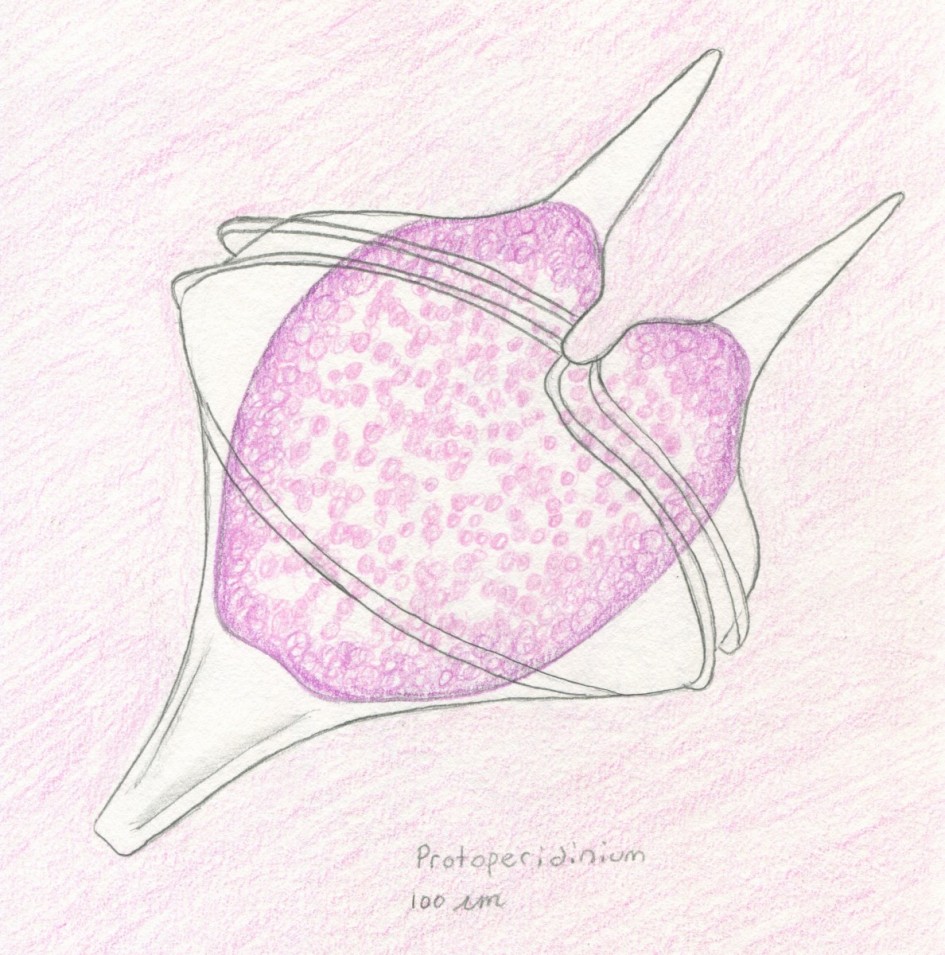By MP
General Information
Protoperidinium are dinoflagellates. Dinoflagellates are “small single-celled organisms, which swim freely in water with a forward spiraling motion propelled by dimorphic flagella… cells have plates as a cell covering, and numerous cellular structures: chloroplasts mitochondria and nucleus, which set them apart from other groups of land plants belonging to microscopic algae” (“Dinoflagellates”, 2016). Protoperidinium cells is globular, polygonal, or equipped with “horns” (“Protoperidinium”, n.d.). For one species, Protoperidinium oceanicum, there is one long slender horn on top of their cell and two at the bottom (“Protoperidinium oceanicum“, 2012). Protoperidinium are heterotrophic. They reproduce both sexually and asexually (“Protoperidinium”, n.d.). Some protoperidinium are also bioluminescent (Buskey, Coulter, & Brown, 1994).
Different protoperidinium species are found in different habitats and many occur seasonally. P. oceanicum occurs in both coastal and oceanic waters from temperate to tropical areas. Another species, P. claudicans, is found in coastal, estuarine, and oceanic waters from temperate to tropical waters but only in the spring and summer (“Protoperidinium claudicans“, 2012). P. steinii occurs in just neritic and oceanic waters worldwide, but only from summer to autumn (“Protoperidinium steinii“, 2012).
Protoperidinium colors often vary depending on the type of prey they consume. For P. steinii, it can be either clear, pink, or yellow in color (“Protoperidinium steinii“, 2012). Many protoperidinium feed by “extruding their cytoplasm out of their theca in the form of a pseudopodium and engulfing the prey items” (“Protoperidinium oceanicum“, 2012). Once the prey is absorbed, the cytoplasm retracts itself back into its theca. A 1997 study found that cultured P. pellucidum fed selectively on diatom species over dinoflagellates and selected between diatom species. It appeared to use chemoreception as the major sensory mode to detect and locate its prey. When P. pellucidum passed a food particle, it would circle a few times before attaching to it, apparently using chemoreception to judge the location of the prey (Buskey, 1997).

The original photo can be found here: http://media.nordicmicroalgae.org/large/Protoperidinium%20depressum_2.jpg
One of the ways protoperidinium and other dinoflagellates are important is that they contribute to the decline of some algal blooms (Jeong & Latz, 1994). Many dinoflagellates are also “primary producers of food in the aquatic food webs. Dinoflagellates are an integral part of the first link in the aquatic food chain: the initial transfer of light energy to chemical energy (photosynthesis). Almost all other organisms are dependent upon this energy transfer for their subsequent existence” (“Dinoflagellates”, 2016).
During my observations of protoperidinium, I learned how the organisms moved in a spinning or spiraling fashion. After diving into literature, I learned that protoperidinium is a complex genus, with many morphologically unique species that all have different preferred habitats and prey. What lesson can they teach us humans? During algal blooms (red tides for example), which can cause large scale mortalities of fish and shellfish, some protoperidinium graze on the bloom and help extinguish it. Only by grazing together can the bloom be affected by the protoperidinium. To them it’s just feeding but perhaps we could learn from this organisms and remember that solving our planet’s problems are best solved by working together. In my protoperidinium animation, the background is completely pink to represent a protoperidinium bloom, ready to feed on the next red tide.
Literature Cited
Buskey, E. (1997). Behavioral components of feeding selectivity of the heterotrophic dinoflagellate Protoperidinium pellucidum. Marine Ecology Progress Series, 153, 77-89. http://dx.doi.org/10.3354/meps153077
Buskey, E., Coulter, C., & Brown, S. (1994). Feeding, growth and bioluminescence of the heterotrophic dinoflagellate Protoperidinium huberi. Marine Biology, 121(2), 373-380. http://dx.doi.org/10.1007/bf00346747
Dinoflagellates. (2016). Naturalhistory.si.edu. Retrieved 16 May 2016, from http://naturalhistory.si.edu/highlight/sem/dinoflagellates.html
Jeong, H. & Latz, M. (1994). Growth and grazing rates of the heterotrophic dinoflagellates Protoperidinium spp. on red tide dinoflagellates. Marine Ecology Progress Series, 106, 173-185. http://dx.doi.org/10.3354/meps106173
Protoperidinium claudicans. (2012). Eoas.ubc.ca. Retrieved 16 May 2016, from https://www.eoas.ubc.ca/research/phytoplankton/dinoflagellates/protoperidinium/p_claudicans.html
Protoperidinium. Encyclopedia of Life. Retrieved 16 May 2016, from http://eol.org/pages/12620/overview
Protoperidinium oceanicum. (2012). Eoas.ubc.ca. Retrieved 15 May 2016, from https://www.eoas.ubc.ca/research/phytoplankton/dinoflagellates/protoperidinium/p_oceanicum.html.
Protoperidinium steinii. (2012). Eoas.ubc.ca. Retrieved 16 May 2016, from https://www.eoas.ubc.ca/research/phytoplankton/dinoflagellates/protoperidinium/p_steinii.html
The original photo for the featured protoperidinium image can be found here: http://oceandatacenter.ucsc.edu/PhytoGallery/images_AM/dinoflagellate/Protoper2_40x_BF_sz.jpg

